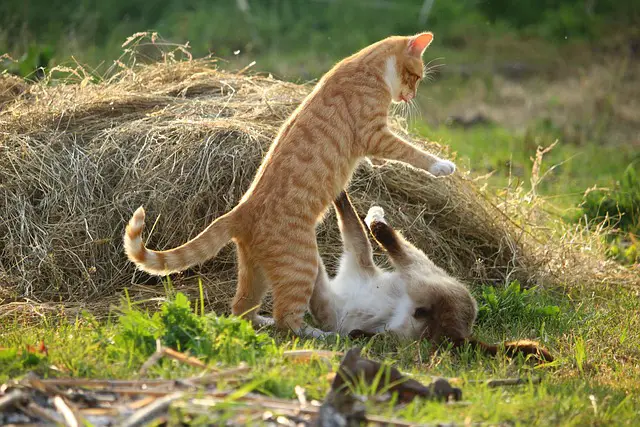Cats are often thought of as solitary animals. While cats can undoubtedly be independent and content to spend time alone, they are also social creatures who need companionship and interaction with other cats. In the wild, cats live in colonies and form relationships with other cats.
However, when two cats come into contact with one another, there is always a risk of aggression. So do cats kill other cats?
Let’s take a closer look at cat-on-cat aggression to understand why this behavior occurs and how it can be prevented.
Do cats kill other cats?
Cats are fascinating creatures, and their instinctual nature is apt to create surprise in many of us.
Though cats do not generally engage in highly aggressive behavior when confronted with another cat, it is certainly possible for a cat to kill another if it is hungry or feels threatened.
While cats may use their sharp claws as weapons, they can also succumb to other factors, such as age or illness.
A young and able-bodied feline might be able to overpower an elderly cat who is suffering from a medical condition.
Additionally, territorial disputes have escalated quickly into fatal fights between cats, regardless of the aggressor’s size or condition.
Though practical coexistence efforts like spay/neuter and proper feeding/hiding spots should be employed where possible to prevent any adverse interaction between cats, it is essential to understand that felines retain their predatory instincts and thus may, under certain circumstances, be capable of unprovoked attacks on other cats.
The Nature of Cat-on-Cat Aggression
Cats can become aggressive for several reasons when interacting with other cats.
One common cause of aggression is territoriality; cats may become aggressive if they feel another cat threatens their territory.
This can be especially true if two unneutered male cats encounter each other while trying to establish dominance over the same area.
Additionally, fear or stress can lead to aggression between two cats; if one cat feels scared or intimidated by another, it may respond by attacking it in self-defense.
How to Reduce Cat Aggression
You can take several steps to reduce the likelihood of your cat becoming aggressive toward another cat.
- First, ensure all cats in your home have been spayed or neutered; this will help reduce territorial behavior in males and keep them from displaying excessive aggression towards one another.
- Second, provide plenty of hiding places for your cats, such as cardboard boxes or tents, so it has an area where it feels safe from potential threats.
- Finally, give your cat plenty of playtime and stimulation, so it does not become bored or stressed out; this will reduce the chances of your cat reacting aggressively when interacting with another one.
How do two cats end a fight?
When two cats are in a fight, specific steps should be taken to de-escalate the situation.
- Firstly, it’s essential to understand why they might be fighting in the first place; cats can use aggression to settle disputes caused by territory, food, or even attention. It is essential, therefore, not to treat them as if they are acting out of spite.
- Secondly, their physical needs must be met – provide fresh drinking water and space away from other animals and humans if possible.
- Finally, give them an environment where peace can return; help them feel safe without being completely isolated.
Over time, with patience and understanding, cats should learn how to interact with one another and resolve their differences peacefully and appropriately.
Conclusion
Cats can display aggressive behavior towards one another for various reasons, including fear and territoriality. However, this type of aggression can be minimized or even eliminated with proper care and management.
By spaying or neutering your cat (if appropriate), providing plenty of hiding places for safety, and ensuring that each cat gets enough playtime and stimulation daily, you can help ensure that your feline friends get along peacefully together. Understanding why this type of aggression occurs is critical to know how to prevent it from happening in the first place.
[su_box title=”Affiliate Disclosure”]This website is supported by its readers. Please assume that all links are affiliate links. If you make a purchase from one of the links we will make a commission from Amazon. Thank you.[/su_box]




